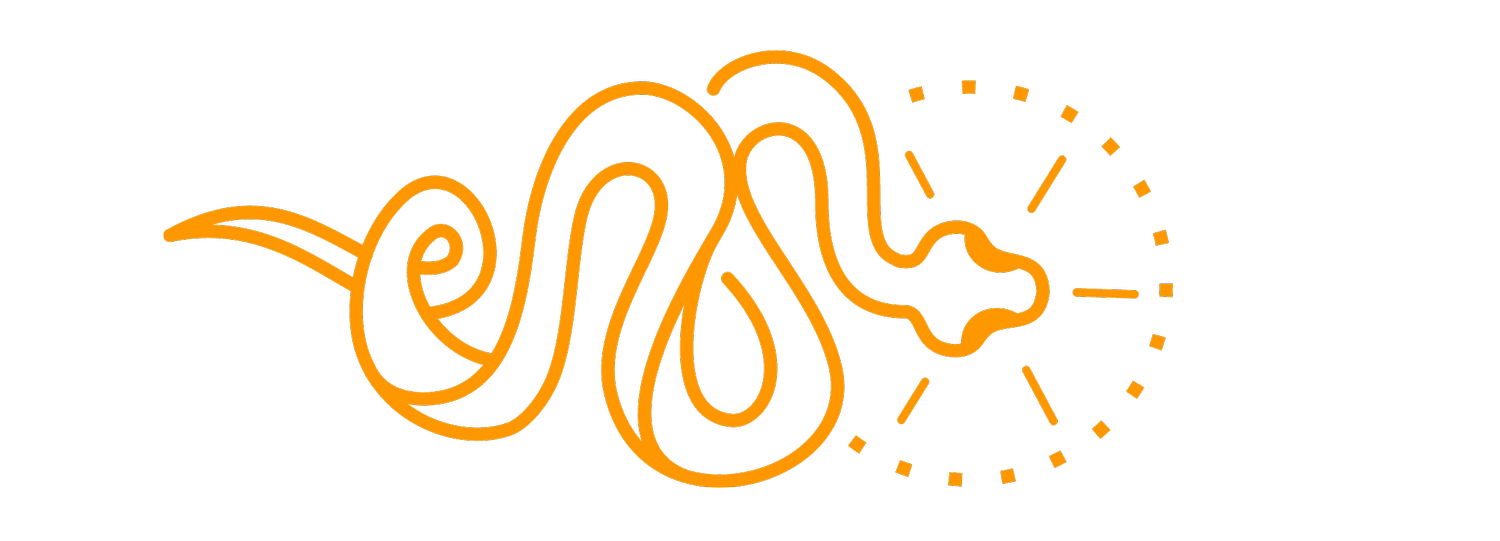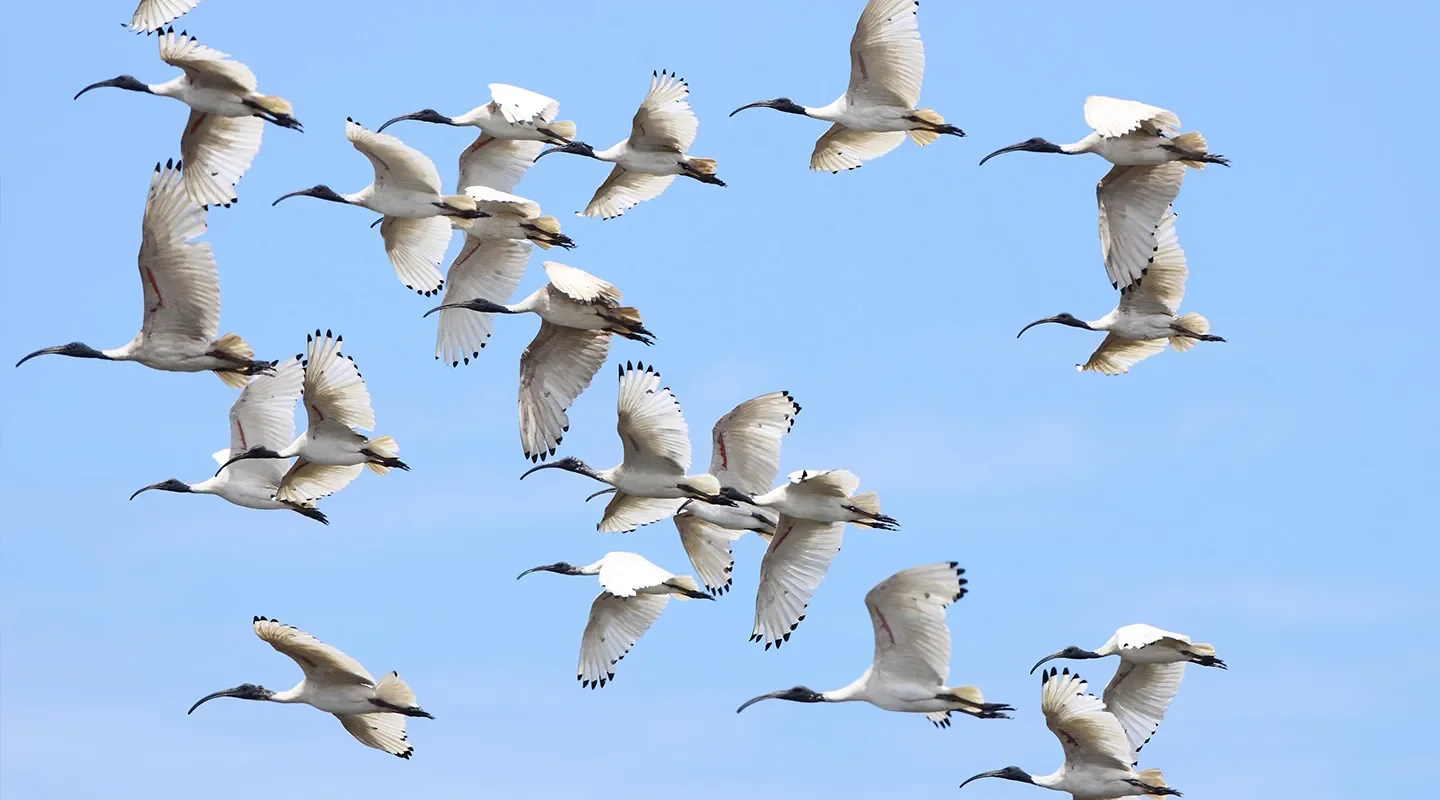The Ibis of Victoria: Guardians of Wetlands, Story, and Season
MLA Educational Series - Country, Animals, and Lore
The ibis — with its long curved beak, graceful stance, and patient movements through mud and shallow water — is one of the most recognisable and symbolically rich birds in Victoria. Known scientifically as Threskiornis molucca, the Australian White Ibis was once a reclusive wetland forager, deeply tied to the rhythms of rivers, lakes, and estuaries. Today, it has also adapted to the urban world, feeding in city parks and waterways — a testament to its resilience and intelligence.
For Victorian Indigenous peoples, including the Wadawurrung, Wurundjeri, Dja Dja Wurrung, and Yorta Yorta, the ibis is far more than a bird. It is a spirit-being, a seasonal messenger, and a keeper of water law — an embodiment of balance between life, decay, and renewal (Howitt 1904; Clarke 2008). Its presence marks the turning of the wet and dry, the abundance of wetlands after rain, and the reminder that all living things must return what they take from Country.
Indigenous Names and Meanings
Across Victoria, the ibis carries many local names and spiritual associations:
Wadawurrung: Djarawok or Djarrook, often translated as “long-curved beak” or “cleaner of the shallows” (Clark 1990).
Woiwurrung (Wurundjeri): Bunjil-dhaura, meaning “water wanderer” — a totem linked to swamp and sky (Howitt 1904).
Yorta Yorta: Binygurra or Binaga, associated with flood season and abundance (Atkinson 2002).
Across southeastern Australia, the ibis is a symbol of purification and continuity — a bird that walks between the worlds of water and sky, of life and decay, transforming what is spent into life again.
Its behaviour — probing the earth for insects, crustaceans, and detritus — mirrors the Indigenous concept of renewal through return: that everything which dies nourishes the next cycle of life.
Origins and Deep Time
The ibis lineage is ancient. Fossil evidence shows that the Threskiornithidae family (ibises and spoonbills) evolved around 60 million years ago during the Paleogene, spreading across the wetlands of Gondwana (Olson 1985).
By the Miocene (23–5 Ma), ibises were widespread across Australia’s lakes and inland rivers, thriving alongside waterbirds such as pelicans, herons, and egrets (Boles 2006).
Their long, curved bills and specialised feeding methods evolved as adaptations to fluctuating wetlands and ephemeral waterways — ecosystems that, like Australia itself, swing between flood and drought.
In this sense, the ibis is both ancient and modern: a survivor of deep-time climatic cycles and a symbol of resilience in today’s changing environments.
Deep-Time and Cultural Timeline
Paleogene (60 Ma): Ancestral ibises emerge in Gondwana’s tropical wetlands (Olson 1985).
Miocene (23–5 Ma): Fossil ibises appear in inland Australia; wetland ecosystems diversify (Boles 2006).
Pleistocene (2.6 Ma–10 ka): Ibises inhabit glacial-period wetlands across Victoria’s plains (Murray 1991).
>40,000 years ago: First Peoples observe ibis migration and integrate its cycles into seasonal knowledge (Howitt 1904).
Pre-1788: Ibis feathers and bones used in ceremony; bird regarded as cleaner of waters and guide of seasonal abundance (Clarke 2008).
1798–1900: Wetland drainage and colonisation reduce ibis nesting sites across the Barwon, Murray, and Gippsland systems.
1900s–Present: Ibises adapt to urban and modified habitats; cultural renewal restores traditional ecological understandings (DELWP 2021; Wadawurrung TOAC 2023).
Ecology and Behaviour
The ibis is a wetland forager and ecological recycler. Its long beak and sensitive nostrils allow it to detect movement and scent below the surface.
It feeds on insects, worms, crustaceans, and carrion — cleaning the landscape and returning nutrients to the system (Kingsford et al. 2010).
Ecological functions include:
Soil aeration: Probing and turning soil for prey improves water flow and nutrient cycling.
Decomposition: Consumes decaying organic matter, preventing disease spread.
Wetland indicator: Large ibis gatherings signal abundant rainfall and restored habitat health.
Their migration follows rainfall — from inland floodplains to coastal wetlands, including the Barwon Estuary, Lake Connewarre, and Western Treatment Plant at Werribee, now major nesting sites for thousands of birds (Parks Victoria 2022).
The Ibis and the Seasons
In Victorian Indigenous calendars, the ibis marks the season of growth and wet renewal — the period following rain when frogs, eels, and freshwater life thrive.
Among the Wadawurrung, its arrival at Lake Connewarre signified the time to gather shellfish and freshwater mussels, and to prepare for eel migration (Wadawurrung TOAC 2023).
For the Wurundjeri, large flocks circling over the Yarra wetlands signalled the shift from cool to warm season, and the renewal of fishing law — no taking of fish before the ibis had arrived.
Its presence on the mudflats and reedbeds was understood as a spiritual indicator — a messenger showing that Country had received enough water, and balance had returned.
A Story from Wadawurrung Country: The Ibis and the Drought
Long ago, the land grew dry. The rivers were dust, and the fish were gone. The people prayed to the sky for rain, but the clouds would not come.
An old ibis, thin and weary, walked across the plains. She used her long beak to dig into the cracked earth, searching for the hidden waters below. Her persistence brought up tiny drops of mud and insects, which she shared with the other birds.
When Bunjil saw her kindness, he sent a great storm that filled the rivers again. The ibis washed her feathers in the rain, her white wings shining once more.
From that time, the people called her Djarawok, “the one who brings back the water.” Whenever the ibis returns to the wetlands, the Wadawurrung know that rain, life, and renewal are near.
(Wadawurrung Traditional Owners Aboriginal Corporation, oral history adapted with permission, 2023.)
The Physics and Biology of the Ibis
The ibis is an elegant demonstration of physics and biological adaptation:
Beak Design: The long, downward-curved beak acts as a mechanical probe, using lever dynamics to reach deep mud layers with minimal effort. Sensitive nerve endings detect vibrations and chemical signals from prey.
Feather Structure: Their white feathers are coated with oils for waterproofing; micro-structural keratin layers reflect sunlight, helping thermoregulation and UV protection.
Flight Mechanics: Broad wings and a high aspect ratio provide efficient lift for long-distance soaring. Ibises fly in V-formations, reducing drag and conserving energy across migrations (Weimerskirch et al. 2001).
Vision and Senses: They have excellent long-range vision, detecting subtle movements in shallow water and sensing infrared temperature variations — ideal for locating prey beneath mud surfaces (Kingsford et al. 2010).
Ecological Physics: Their collective roosting patterns increase local humidity and fertilise soil beneath nesting sites, influencing microclimates and plant regeneration.
The ibis, in both physics and spirit, is a bridge between earth, water, and air — a living cycle of matter and movement.
Colonial Impacts and Adaptation
European colonisation brought massive environmental change. Wetlands such as Lake Corangamite, Werribee Marshes, and Port Phillip Bay inlets were drained for agriculture, drastically reducing ibis habitat (Flannery 1994).
As natural feeding grounds vanished, ibises adapted — turning to urban parks, rubbish tips, and reservoirs.
To some, they became a “bin chicken”; to others, a powerful symbol of survival amid disruption — embodying the same adaptability that allowed First Peoples to endure colonisation and cultural dislocation.
In Wadawurrung philosophy, this shift is seen not as degradation but as transformation — proof that life, like water, always finds its way.
Conservation and Cultural Renewal
Modern conservation and cultural restoration efforts recognise the ibis as both ecological engineer and spiritual messenger:
Wetland restoration projects across the Barwon, Werribee, and Gippsland regions support ibis breeding and habitat recovery (Parks Victoria 2022).
Traditional ecological knowledge guides seasonal water releases and fire management.
Community education programs highlight the ibis’ cultural role as a “cleaner and restorer” rather than a pest.
Collaborative monitoring by Indigenous rangers and scientists ensures the bird’s cycles remain part of Victoria’s living ecological law.
The ibis’s continued presence across both wild and urban landscapes shows that Country still speaks, and the old rhythms still move beneath the concrete.
Symbolism and Meaning
In science, the ibis represents ecological resilience — an indicator species for wetland health.
In Indigenous knowledge, it is a spirit of renewal and humility, reminding people to care for what is easily overlooked.
Its curved beak, like a question mark, symbolises curiosity, persistence, and the search for life beneath the surface.
Through both drought and abundance, the ibis teaches that balance is not constant — it must be continually restored through care, respect, and listening to Country.
Conclusion
The ibis — elegant, adaptable, and sacred — embodies the union of earth, air, and water.
Its story in Victoria spans millions of years, from the wetlands of Gondwana to the city skylines of today.
For Indigenous peoples, it remains a messenger of renewal and a keeper of water law, guiding when to gather, when to rest, and when to give back.
To honour the ibis is to honour the cycles of Country itself — the endless rhythm of drying and flooding, decay and rebirth, life and return.
References
Atkinson, W. (2002). People of the River: The Yorta Yorta and Their Homelands. Melbourne University Press, Melbourne.
Boles, W.E. (2006). “Fossil birds of Australia.” Memoirs of the Queensland Museum, 52(1), pp. 1–25.
Clark, I.D. (1990). Aboriginal Languages and Clans: An Historical Atlas of Western and Central Victoria, 1800–1900. Monash University, Melbourne.
Clarke, P.A. (2008). Aboriginal Healing Practices: Smoke, Fire and Water in South-Eastern Australia. Aboriginal Studies Press, Canberra.
DELWP (2021). Biodiversity 2037 Strategy. Department of Environment, Land, Water and Planning, Melbourne.
Flannery, T. (1994). The Future Eaters: An Ecological History of the Australasian Lands and People. Reed Books, Sydney.
Howitt, A.W. (1904). The Native Tribes of South-East Australia. Macmillan, London.
Kingsford, R.T., Bino, G. & Porter, J.L. (2010). “Waterbirds of the Murray–Darling Basin.” Wetlands Ecology and Management, 18(5), pp. 699–716.
Murray, P.F. (1991). “Pleistocene vertebrate faunas from Victoria.” Records of the Australian Museum, 43, pp. 35–52.
Olson, S.L. (1985). The Fossil Record of Birds. Avian Paleontology, Smithsonian Institution Press, Washington, D.C.
Parks Victoria (2022). Wetland Restoration and Bird Habitat Report. State Government of Victoria, Melbourne.
Wadawurrung Traditional Owners Aboriginal Corporation (TOAC). (2023). Waterbirds and Wetland Knowledge of Wadawurrung Country. Geelong.
Weimerskirch, H. et al. (2001). “Energy savings in flight formation.” Nature, 413(6857), pp. 697–698.
Written, Researched and Directed by James Vegter (22 September 2025)
MLA
Sharing the truth of Indigenous and colonial history through film, education, land, and community.
www.magiclandsalliance.org
Copyright MLA – 2025
Magic Lands Alliance acknowledges the Traditional Owners, Custodians, and First Nations communities across Australia and internationally. We honour their enduring connection to the sky, land, waters, language, and culture. We pay respect to Elders past, present, and emerging, and to all First Peoples’ communities and language groups. This article draws only on publicly available information; many cultural practices remain the intellectual property of their respective communities.


